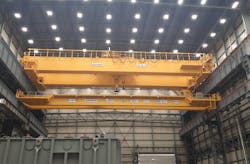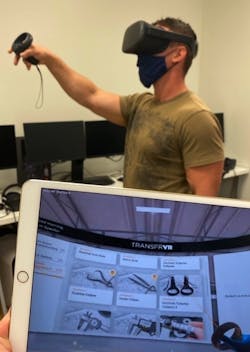Editor's Note: Tony Wojciechowski, chief human resource officer at Hyundai Power Transformers USA, and Bharani Rajakumar, CEO, TRANSFR, will be presenting at The Manufacturing &Technology Show. being held in Cleveland, Ohio, Nov. 9-11, 2021.
One of the great benefits of new technology is that while it is invented for one particular use, it always has further applications. Additionally, it offers benefits beyond the actual technology.
Let’s start with the benefits. The state of Alabama had an issue. Analyzing its workforce situation, the state knew it had to provide its population with the updated skills that industries require. And the industry at the top of the list is manufacturing. The state is the fifth largest manufacturer in the country and accounts for 17% of Alabama’s total economic output according to the National Association of Manufacturers. That means the economic impact was $38 billion as of 2018. From a job perspective in 2019, the sector accounted for 13% of the state’s jobs at 271,000.
The state has a large base of both aerospace and automotive manufacturing. Over 300 aerospace companies including Boeing, Lockheed Martin, GE Aviation, Raytheon, Collins Aerospace, and GKN Aerospace call this state home. Airbus also has its only U.S. plant in Alabama. On the automotive side Mercedes, Honda and Hyundai, and Mazda-Toyota operate plants here. And the automotive supplier network includes 150 major companies. In fact, the state ranks third in the country in vehicle exports.
As Alabama’s manufacturing base continues to grow, the challenge is to make sure that the talent pipeline expands. Equally, if not more important, that talent needs to possess the right skills that meet companies’ needs. To address this issue, in 2018 Alabama Governor Kay Ivey set a goal to add 500,000 highly skilled employees to the state’s workforce by 2025.
Though that directive is a tall order, Ed Castile, deputy secretary of the Workforce Development Division of Made in Alabama, and the director of the Alabama Industrial Division of Training (AIDT), has a good track record. For the past four years, he has been working hard to determine the skills set needed and consequently create training programs to addresses those needs. He has developed programs for companies including Mercedes-Benz and Airbus, that consist of cooperative, on-site workforce training.
Just last month, Castile’s division AIDT along with Hyundai Power Transformers USA, Inc. (HPT), announced the launch of a new virtual reality (VR) simulation program to upskill workers across the state for jobs in the manufacturing sector.
Adapting virtual reality made sense from several angles. “We looked at our demographics and felt the younger people who grew up with technology, would respond well to using these types of technology in their jobs,” Castile explained. “It takes the courage of companies like Hyundai Power Transformers, to step up and take risks bringing in new technology like virtual reality and use it for training.” Hyundai Power Transformers USA, Inc. (HPT), which started as one of the affiliated factories of Hyundai Electric Systems is located in Montgomery, Alabama, and is a subsidiary company of Hyundai Heavy Industries The company creates power transformers for various requirements. In 2018 the company expanded to establish a “Smart Factory.” The expansion also included a new training facility.
The VR training was provided by TRANSFR, a VR company. Using Oculus Quest headset workers were able to simulate the experience of using multi-ton cranes to hoist objects as large as 800,000 pounds. “When Ed brought these ideas to us, a week before COVID hit, we talked it over with senior management as well as our EHS manager and we worked with TRANSFR to develop specific programs for cranes,” says Tony Wojciechowski chief human resource officer at HPT. “Given the size of these cranes and the potential for safety issues, using VR to train was ideal. Working on this type of equipment is intimidating so by using VR you can run through simulations and corrections and then feel comfortable by the time you actually operate the machinery. Using this technique is a faster, safer, and more interesting way to train people. And this type of training gets people excited about the job and leads to both job attraction and attention.”
The training program is part of an apprenticeship program at HPT and using VR can help employees reach various certifications quicker. Wojciechowski envisions wide usage of this tool for a variety of processes. “For dangerous processes, VR can ensure that someone has the proper training as an employee needs to be competent in one level before moving up to the next. And it’s standardizing training.”
The training can also be used even before someone comes on board. “We use the VR simulation in pre-employment testing, to make sure that this type of job is a good fit for the potential candidate,” says Wojciechowski.
Training potential candidates is why Bharani Rajakumar decided to create his company TRANSFR. Calling his system an alternative pathway to career success, he explains that the hands-on, simulation-based training provides people with the skills they need to secure a job.” Our mission to give people the skills they need to find jobs and improve their lives,” says Rajakumar.
A hands-on experience is how people truly learn, says Rajakumar rather than lectures, videos, and PowerPoint presentations. As they use the simulations, there is a digital coach that is available for assistance. This virtual representation can replicate the job environment anywhere. And for companies unable to afford a training facility this is an ideal method of learning.
TRANSFR has found that users who engage with VR as part of their workplace training have been found to be more efficient, correct errors more quickly, and have a higher self-reported feeling of confidence compared to users who have used traditional training. And nearly half of the trainees scored at or above 90% on the real-world transfer test with no prior human coaching or hands-on experience with the tools.
“This method of training has show success in pilots we have done for other manufacturing companies, both in terms of employees preferring this method and in terms of job retention,” says Rajakumar.
Job retention is of course at the top of the list of every company's goals. Bringing in technology to either pre-screen employees and find the best fit or using technology to train employees in a manner that gets them involved and excited about their jobs causing them to stay with the company, is an effective workforce strategy solution.
Both keeping and attracting new employees is Wojciechowski’s goal as his company continues its growth trajectory. "This application of VR harnesses the potential of immersive learning to train and certify employees on critical, in-demand skills at an unprecedented scale,” says Wojciechowsk.
About the Author
Adrienne Selko
Sr. Editor
Focus: Workforce, Talent
Email: [email protected]
Follow Me on Twitter: @ASelkoIW
Senior Editor Adrienne Selko has written about many topics over the 17 years she has been with the publication and currently focuses on workforce development strategies. She is also a senior editor at Material Handling & Logistics and EHS Today.
Previously Adrienne was in corporate communications at a medical manufacturing company as well as a large regional bank.
She is the author of Do I Have to Wear Garlic Around My Neck?, which made the Cleveland Plain Dealer's best sellers list.


